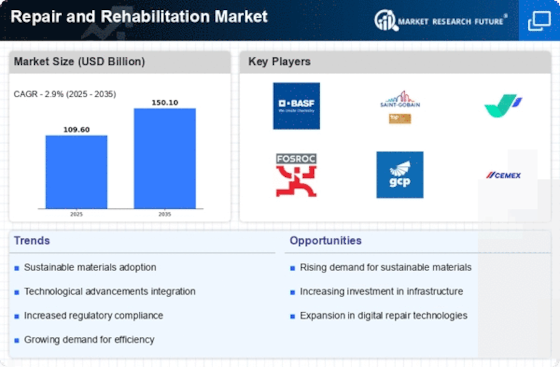Increased Infrastructure Investment
The Repair and Rehabilitation Market is experiencing a surge in infrastructure investment, driven by the need to modernize aging facilities and enhance public safety. Governments and private entities are allocating substantial budgets to repair and rehabilitate roads, bridges, and public buildings. For instance, recent data indicates that infrastructure spending has increased by approximately 10 percent in the last year alone, reflecting a growing recognition of the importance of maintaining structural integrity. This trend is likely to continue as urbanization accelerates and the demand for robust infrastructure rises. Consequently, the Repair and Rehabilitation Market stands to benefit significantly from these investments, as they create opportunities for contractors and service providers to engage in extensive repair projects.
Aging Infrastructure and Urbanization
The Repair and Rehabilitation Market is significantly impacted by the challenges posed by aging infrastructure and rapid urbanization. Many regions are grappling with deteriorating roads, bridges, and public facilities that require urgent attention. Data suggests that over 30 percent of infrastructure in certain areas is classified as being in poor condition, necessitating immediate repair and rehabilitation efforts. Urbanization further exacerbates this issue, as increased population density places additional strain on existing infrastructure. As cities expand, the demand for effective repair solutions becomes paramount. This scenario presents a substantial opportunity for the Repair and Rehabilitation Market, as stakeholders seek innovative approaches to address these pressing infrastructure challenges.
Regulatory Compliance and Safety Standards
The Repair and Rehabilitation Market is increasingly influenced by stringent regulatory compliance and safety standards. Governments are implementing more rigorous codes and regulations to ensure that structures meet safety requirements, particularly in sectors such as construction and transportation. This regulatory environment compels companies to invest in repair and rehabilitation services to avoid penalties and ensure compliance. For example, the introduction of new safety regulations has led to a 15 percent increase in demand for rehabilitation services in the construction sector. As organizations strive to adhere to these standards, the Repair and Rehabilitation Market is poised for growth, as companies seek to enhance their operational safety and mitigate risks associated with non-compliance.
Sustainability and Environmental Considerations
The Repair and Rehabilitation Market is increasingly aligning with sustainability and environmental considerations. There is a growing emphasis on eco-friendly repair practices that minimize environmental impact. This shift is driven by both regulatory pressures and consumer demand for sustainable solutions. For example, the adoption of recycled materials in repair projects has been shown to reduce waste and lower carbon footprints. Recent studies indicate that projects incorporating sustainable practices can lead to cost savings of up to 20 percent over their lifecycle. As stakeholders prioritize sustainability, the Repair and Rehabilitation Market is adapting to meet these expectations, creating opportunities for companies that specialize in environmentally responsible repair solutions.
Technological Advancements in Repair Techniques
The Repair and Rehabilitation Market is witnessing a transformation due to technological advancements in repair techniques. Innovations such as advanced materials, robotics, and data analytics are revolutionizing how repairs are conducted. For instance, the use of drones for inspection and monitoring has gained traction, allowing for more efficient assessments of structural integrity. Additionally, smart materials that can self-repair are emerging, potentially reducing long-term maintenance costs. These technological developments not only enhance the effectiveness of repair processes but also improve safety and reduce downtime. As these technologies become more widely adopted, the Repair and Rehabilitation Market is likely to experience increased efficiency and effectiveness in service delivery.

















Leave a Comment